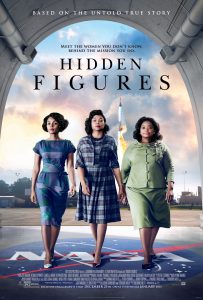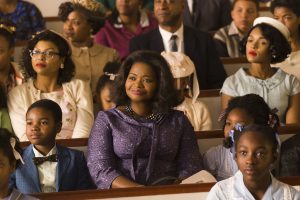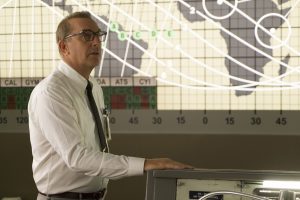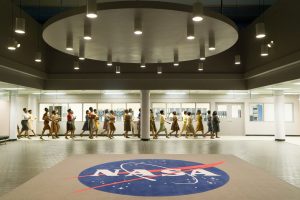
If there is one thing Theodore Melfi is great at, it’s in directing characters. He has such a genteel approach, guiding them along with a soft touch. His understanding and affection for them is so pleasant that it enlivens their spirits. The cutesy moments they engage in come across so delightfully, the hardships they face made powerful by their infliction. They may at times indulge in conventionalities, but never come across as caricatures. They are real human beings underneath their occasional hyperbole.
It’s a good thing for Melfi that “Hidden Figures” is a character piece as the endearing performances must carry a lot of the weight. For where he succeeds in directing characters, he stumbles in handling situational drama. It’s not that his direction of events is bad, just vanilla and workmanlike. He is more concerned with bringing to screen the true events that shaped NASA’s orbiting of Earth that he forgets to instill life into them. There is not so much energy and verve in the proceedings, but dry reenactments. And yet, it works.

Katherine Johnson (Taraji P. Henson), Dorothy Vaughan (Octavia Spencer) and Mary Jackson (Janelle Monae) are three brilliant African-American women working at NASA, who served as the brains behind one of the greatest operations in history: the launch of astronaut John Glenn into orbit. Photo Credit: Hopper Stone.
It works because of the performances. All of that energy and verve was put into the characters, who convey the severity of their situations when the direction doesn’t. The uncomfortableness of segregation is not felt in the subdued direction, but in the raw honesty within the three lead performances. They are Katherine Johnson (Taraji P. Henson), Dorothy Vaughan (Octavia Spencer), and Mary Jackson (Janelle Monáe), three intelligent women working for NASA in the sixties. They all have aspirations within the company, whether it be as a physicist, an engineer, or a supervisor. All three are held back by the color of their skin and their gender, but persevere with grit and determination.
Henson perfectly captures the modesty of Johnson, a timid soul amongst physicists who look down upon her. While the immediacy of her ordeal isn’t felt in the direction, it’s felt in her performance. She trembles in her chair as the pressure mounts, headstrong throughout her ordeal, then exerting herself when her confidence arrives. The racial inequality is also felt in Monáe’s sterling performance, capturing the charming confidence of the woman who would become the first African-American engineer. Through arguments with her husband and disproval of the courts, her struggle is felt by the pained determination in her eyes. The same goes for Vaughan, wonderfully portrayed by Spencer, whose patience is clearly being tested with each passing day. There is a moment when confronted by her superior, Vivian Mitchell (Kirsten Dunst), that she stands her ground without shouting and causing a scene. It is her poised expression that nets her respect; a satisfying moment for sure.

Kevin Costner stars as NASA official Al Harrison, in HIDDEN FIGURES. Photo Credit: Hopper Stone.
Nobody better conveys the immediacy of the NASA missile launch than Kevin Costner as Al Harrison, the director of the Space Task Group. His haggard sway goes a long way in detailing the exhaustive nature of the mission. The grueling task mixed with the racial tension is palpable thanks in part to his stoic performance. He never comes across as a blowhard but a caring boss who pushes his workers (and himself) to their very limits in order to succeed. His heartwarming moments are earned due to how sincere they come across as, such as when he bats down the colored restrooms signs in a show of equality and stands behind Katherine proudly in a board meeting amidst tension.
Credit also goes to Jim Parsons in avoiding making his portrayal of Paul Stafford out to be nothing more than a self-absorbed monster. He addresses his dismissal of Katherine not so much as mere sexism and racism, but fear of a superior talent hijacking his position. Mounting pressure from Harrison has his mathematical slip-ups magnified and when Katherine corrects them, he feels undermined. He resorts to class segregation as a means to dissuade the pendulum against her. He is a scared man acting out of survival, crude as it may seem. His eventual growth is subtle and nuanced.

HIDDEN FIGURES is the incredible untold story of brilliant African-American women working at NASA, who served as the brains behind one of the greatest operations in history: the launch of astronaut John Glenn into orbit, a stunning achievement that restored the nation’s confidence, turned around the Space Race, and galvanized the world. The visionary trio crossed all gender and race lines to inspire generations to dream big. Photo Credit: Hopper Stone.
Each of these characters is swallowed up at least once by movie magic. Katherine has her moment of redemption when, after having the doors of the mission control center shut on her, is ushered in to celebrate her successful efforts after a perfectly timed imaginary countdown (i.e. she starts to walk away dejectedly, only for the doors to swing open on the count of three). Jackson invokes a riveting speech that floors a biased judge, having him complete a one-eighty in favor of her engineering school desires at the snap of a finger. Vaughan sneaks into a computer room to learn IBM software, miraculously fixing the system at the most opportune moment. Even their love lives are subjected to these moments, such as a touching moment between Katherine and her beau, Jim (Mahershala Ali), that is sappy yet emotionally rewarding. While these moments do diminish the authenticity of the events, downplaying their severity in favor of mawkishness, they are made palatable thanks to Melfi’s genuine handle.
“Hidden Figures” is so earnest that it becomes hard to resist. The assured performances bolster the sincerity of the events. While Melfi’s adherence to the facts is a double-edged sword (great that he did well by them, but also prevented his direction from forming an identity in the process), the real-life story is compelling enough to engage one’s attention. For these reasons alone, “Hidden Figures” is a successful crowd-pleasure, as vanilla as it may seem!
Final Rating: B
